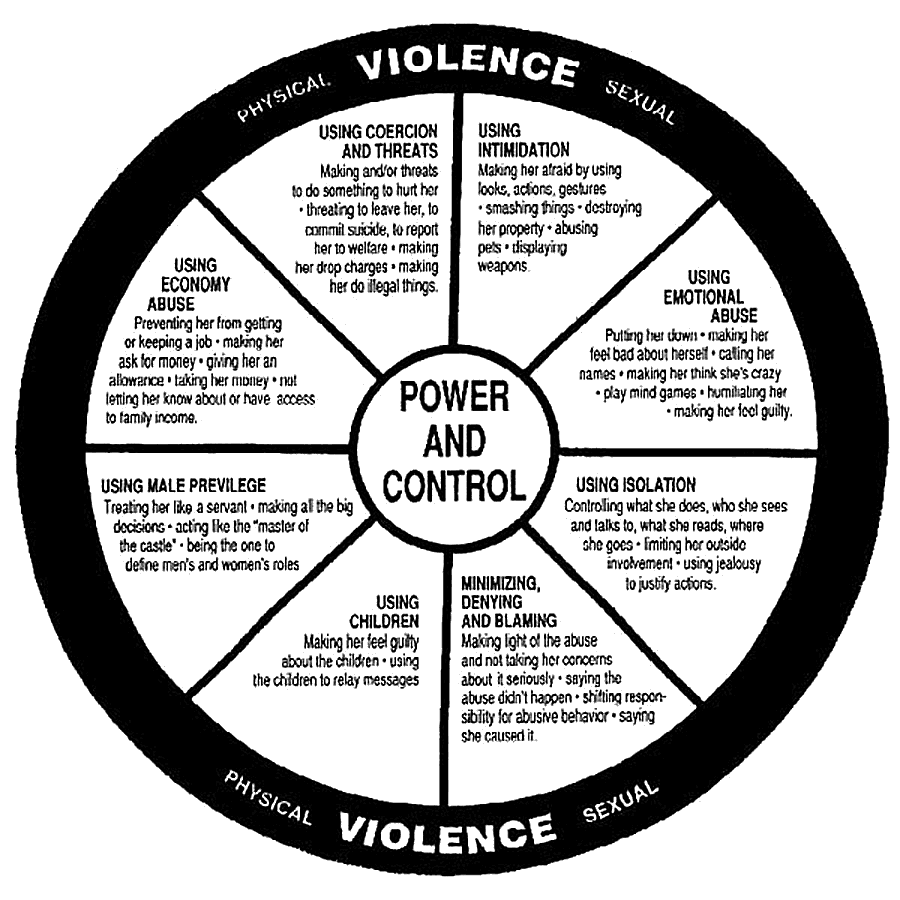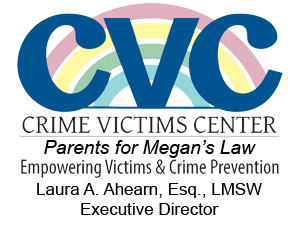Help/Links - Domestic Violence
Domestic violence involves a range of behaviors which can include physical and sexual violence; using coercion and threats; using intimidation; using emotional abuse, using isolation; minimizing, denying and blaming; using children; using male privilege; and using economic abuse. These forms of abuse do not occur in isolation from each other, but rather occur simultaneously. The Power and Control model of Domestic Violence identifies power and control as the goal of all of these tactics of abuse because victims' experiences consistently indicate that the behavior of their partners is not random or arbitrary, but purposeful and systematic. The goal of abusers'
behavior is to exert control over their partners. This goal reflects their belief that they have a right and entitlement to control their intimate partners. The various forms of abuse, the different behaviors, are used a tactics of control.

Using Coercion and Threats
- making and/or carrying out threats to do something to hurt her/him
- threatening to leave her/him, to commit suicide, to report her/him to welfare
- making her/him drop charges
- making her/him do illegal things
Using Intimidation
- making her/him afraid by using looks, actions, gestures
- smashing things
- destroying her/his property
- abusing pets
- displaying weapons
Using Emotional Abuse
- putting her/him down
- making her feel bad about herself/himself
- calling her/him names
- making her/him think he/she is crazy
- playing mind games
- humiliating her/him
- making her/him feel guilty
Using Isolation
- controlling what he/she does, who he/she sees, and talks to, what he/she reads, where he/she goes
- limiting her/his outside involvement
- using jealousy to justify actions
Minimizing, Denying and Blaming
- making light of the abuse and not taking her concerns about it seriously
- saying the abuse didn't happen
- shifting responsibility for abusive behavior
- saying he/she caused it
Using Children
- making her/him feel guilty about the children
- using the children to relay messages
- using visitation to harass her/him
- threatening to take the children away
Using Male Privilege
- treating her like a servant
- making all the big decisions
- acting like the "master of the castle"
- being the one to define men's and women's roles
Using Economic Abuse
- preventing her/him from getting or keeping a job
- making her/him ask for money
- giving her/him an allowance
- taking her/him money
- not letting her/him know about or have access to family income
Based on the Power and Control Model developed by the Domestic Abuse Intervention Project, Duluth, Minnesota.
Resources:
In New York : Order of Protection Notification System
In Suffolk County New York Only: How to File for an Order of Protection in Suffolk County Family Court
In Suffolk County New York Only: Como Solicitar una orden de Protección con la Corte Familiar en el Condado de Suffolk
In Suffolk County New York Only:Medical Practitioner's Guide to Assisting Victims of Domestic Violence in Suffolk County - English
In Suffolk County New York Only:Medical Practitioner's Guide to Assisting Victims of Domestic Violence in Suffolk County - Spanish
In Suffolk County New York Only:Medical Practitioner's Guide to Assisting Victims of Domestic Violence in Suffolk County - Haitian Creole
In Suffolk County New York Only:Medical Practitioner's Guide to Assisting Victims of Domestic Violence in Suffolk County - Simple Chinese
Help for Senior Victims of Family Violence and Financial Scams - English
Help for Senior Victims of Family Violence and Financial Scams - Spanish
Help for Senior Victims of Family Violence and Financial Scams - Haitian Creole
Help for Senior Victims of Family Violence and Financial Scams - Simple Chinese
National Domestic Violence Hotline
1-800-799-SAFE (7233)
1-800-787-3224 (TTY)
NYS Coalition Against Demostic Violence
1-800-942-6906
TTY: 1-800-818-0656
Spanish language 1-800-942-6908
Spanish language TTY: 1-800-780-7660
In NYC: 1-800-621-HOPE (4673) or dial 311
TTY: 1-866-604-5350
The Retreat - Domestic Violence Victim Services and Support/Residential Shelter - Serving Easter Long Island - www.theretreat.org - Hotline - (631)-329-2200
Additional Helpful Links:
National Center on Domestic and Sexual Violence
National Runaway Switchboard
ACOG Violence Against Women Site
Asian Task Force Against Domestic Violence
Battered Women’s Justice Project
CAVNET –Communities Against Violence Network
Corporate Alliance to End Partner Violence
Department of Justice’s Office on Violence Against Women
Donate A Phone
Family Violence and Sexual Assault Institute (FVSAI)
Health Resource Center on Domestic Violence
Institute for Law and Justice
Jane Doe, Inc.
Legal Momentum
Minnesota Center Against Violence and Abuse /MINCAVA
National Center for Victims of Crime
National Clearing House for the Defense of Battered Women
National Coalition Against Domestic Violence
National Electronic Network on Violence Against Women (VAWnet)
National Immigration Project of the National Lawyers Guild
National Judicial Institute on Domestic Violence
National Network on Behalf of Battered Immigrant Women
National Network to End Domestic Violence
National Resource Center on Domestic Violence
National Violence Against Women Prevention Research Center
National Workplace Resource Center on Domestic Violence
Safe At Home – CA Sec. of State
Soroptimist Women’s Opportunity Award
U.S. Department of Justice Office for Victims of Crime
U.S. DOJ – Violence Against Women Office
VAWNET
Women’s Law Initiative
Getting a U-Visa - Immigration Help for Crime Victims
Cómo obtener una visa- Ayuda inmigratoria para victimas de crimen
